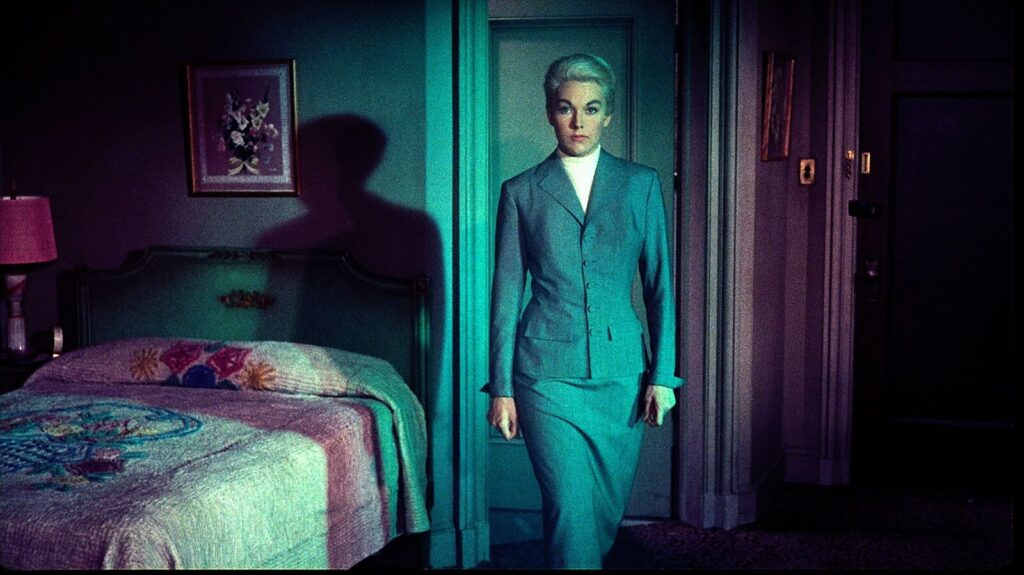
Hitchcock’s masterpiece, Vertigo (1958), is a modern dress retelling of the 11th century romantic tale of Tristan and Iseult (or Isolde).
Denis de Rougemont calls this tale the “Great European myth of adultery.”
The Tristan and Iseult Story
What follows is the version of the Tristan story as recounted by de Rougemont in Love in the Western World (1940).
Tristan, an orphan, has been raised by King Mark of Cornwall, who sends him to Ireland to bring back the Irish princess, Iseult. On the way back to Cornwall, the two drink a love potion. “The effect is to commit them to a fate from which they can never escape during the remainder of their lives, for they have drunk their destruction and death.”
Adultery ensues. Four barons of the king tell their sovereign of this adultery. Entrapped by the barons, Tristan and Isolde are sentenced to death. But Tristan escapes and rescues Iseult. Eventually Iseult returns to King Mark but the lovers still have several rendezvous.
“Fresh adventures carry Tristan far away from Iseult, and he then comes to suppose that she no longer loves him. So he agrees to marry ‘for her beauty and her name’ another Iseult, Iseult ‘of the White Hand’. And indeed this Iseult remains unstained, for after their marriage Tristan still sighs for ‘Iseult the Fair’.”
Tristan is wounded by a poisoned spear and sends for the first Iseult, Queen of Cornwall, “she alone who can save his life.” She comes in a ship with a white sail. The second Iseult, out of jealousy tells Tristan that the sail is back. Tristan dies. Iseult One arrives and dies too.
Vertigo Parallels
- Scotty Ferguson is Tristan
- Gavin Elster is King Mark.
- Madeleine Elster is Isolde One.
- Judy Barton is Isolde Two.
Scotty Ferguson is charged with guarding the wife of shipping magnate, Gavin Elster, Madeleine, who is obsessed with a dead ancestor, Carlotta Valdez. Scotty, in a series of wordless scenes, follows Madeleine around San Francisco, accompanied by Bernard Herrmann’s music expressing romantic yearning.
Though no actual adultery is depicted on screen, several scenes suggest a strong romantic involvement (Scotty’s rescue of Madeleine from the San Francisco Bay, the scene in the Muir Woods).
Madelein leaps from the roof of the Mission San Juan Bautista, and due to his vertigo, Scotty is unable to save her.
An inquest follow in which Scotty is reprimanded by the judge for his failure. Scotty becomes catatonic.
Eventually he meets Judy Barton who bears a strong resemblance to Madeleine Elster. Scotty remakes Judy as Madeleine (clothes, hair), and they have an affair. Scotty discovers the truth, that Judy portrayed Madeleine. He drags her to the scene of her crime, the Mission, but she falls from the roof as a nun approaches.
More parallels
- Scotty’s reprimand is Tristan’s wound
- His catatonia is Tristan’s illness.
- He years for Madeleine (Isolde One)
- He makes do with Judy Barton (Isolde Two)
- The nun’s appearance on the roof of the mission is the black sail.
Bernard Herrmann’s Score
The best known retelling of the Tristan story is Wagner’s opera, Tristan und Isolde, which has all of the elements of the original myth, except that there is no second Isolde.
However, Bernard Herrmann writes a score that is Wagnerian in scoring and melody. The scenes with Scotty and Madeleine are accompanied by Wagnerian yearning. The consummation of Scotty and Judy’s affair has music with a Wagner turn.
As if in homage to the story’s medieval roots, Hitchcock carries what appears to be a hunting horn in his cameo.

See a companion piece on Fellow Travelers.
Leave a Reply